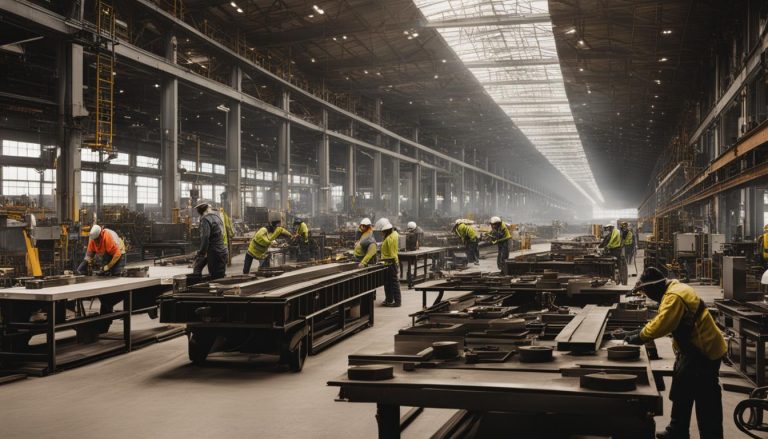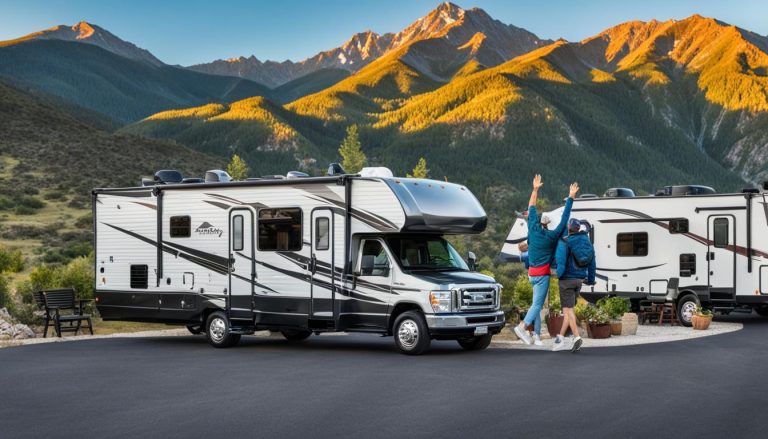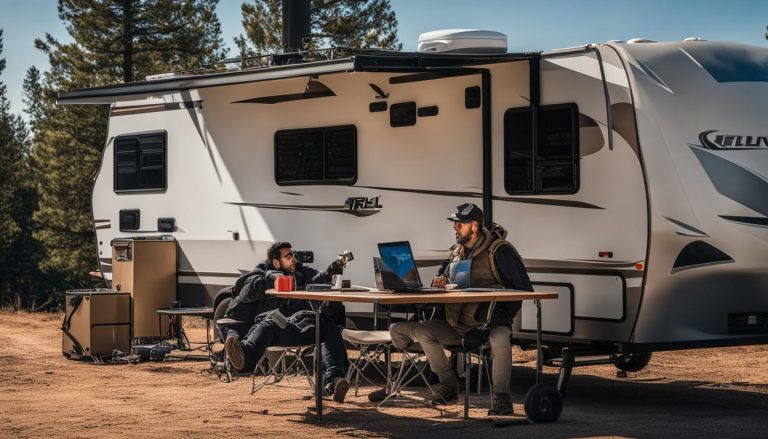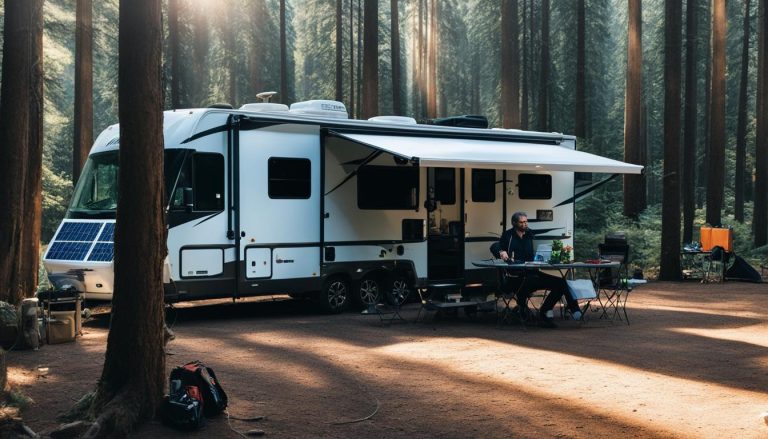Safely Plug Your RV Into Your Home – Easy Guide
gorvlifestyle.com and its partners may earn a commission if you purchase a product through one of our links
When it comes to plugging your RV into your home’s electrical system, there are a few important factors to consider for a safe and smooth connection. In this easy guide, we’ll walk you through the steps you need to follow when connecting your RV to your house power supply. While it’s not recommended to live in an RV outside a home for an extended period of time, short trips can be accommodated by connecting your RV to a standard household outlet. However, keep in mind that the power capacity of a home’s electrical system may be limited compared to the 30/50 Amp hookup typically required by an RV. As a result, you’ll need to be aware of the appliances you can run and the duration of usage to avoid overloading the system and tripping breakers.
Key Takeaways:
- Make sure to use the correct adapters for plugging your RV into a home’s electrical system.
- Be mindful of the power capacity of a home’s electrical system compared to a dedicated RV hookup.
- Avoid using power-hungry appliances for long durations or simultaneously with other devices to prevent overloading the system.
- Consider alternative power sources, such as using appliances in the house you’re parked in front of, when using a home electrical connection.
- Always follow the recommended steps and consult experts if you have any doubts or concerns.
Connecting Your RV to a Home’s Electrical System
When it comes to connecting your RV to a home’s electrical system, you have two options. The first is to ensure that your RV is equipped with the necessary electrical hookups when you purchase it. This means having a built-in connection that allows you to plug your RV directly into a power source.
The second option is to install a 30/50 Amp hookup at your home if you plan on regularly visiting a specific location. This involves hiring a professional electrician to install the necessary wiring and outlets to accommodate your RV’s power needs.
If you’re using a home’s standard outlet, you can still connect your RV with the right equipment. You’ll need an outdoor, all-weather extension cord and a 15/20 Amp adapter to match the power supply. It’s important to use a short extension cord to prevent overheating and ensure a stable connection.
Before connecting your RV to the home’s electrical system, take the following precautions:
- Turn off all electrical appliances in your RV.
- Switch off the breakers in your home.
Once you’ve taken these safety measures, you can begin the connection process:
- Plug the extension cord into your RV’s electrical hookups using an adapter if necessary.
- Reset the breakers in your home.
If the breaker trips after resetting, unplug everything, double-check that all appliances in your RV are turned off, and try again. If the issue persists, consult your RV’s manual or reach out to the manufacturer or dealership for further assistance.
Connecting your RV to a home’s electrical system can provide convenience and comfort during your trips, but it’s important to follow proper procedures and ensure a safe connection. Whether through built-in hookups or additional installations, connecting your RV to a home’s power supply can enhance your RVing experience.
Using Appliances Safely with a Home Electrical Connection
When using appliances with a home electrical connection, it is crucial to understand the power limitations compared to a dedicated RV hookup. While a home connection can handle simultaneous usage of appliances such as TVs, DVD players, laptops, and refrigerators without overloading even a 15/20 Amp connection, caution is advised when using power-hungry devices. Appliances like air conditioning, heaters, hairdryers, microwaves, toasters, and toaster ovens require more power and should be used sparingly or with alternative power sources to avoid flickering lights or tripping the electrical connection between your RV and home.
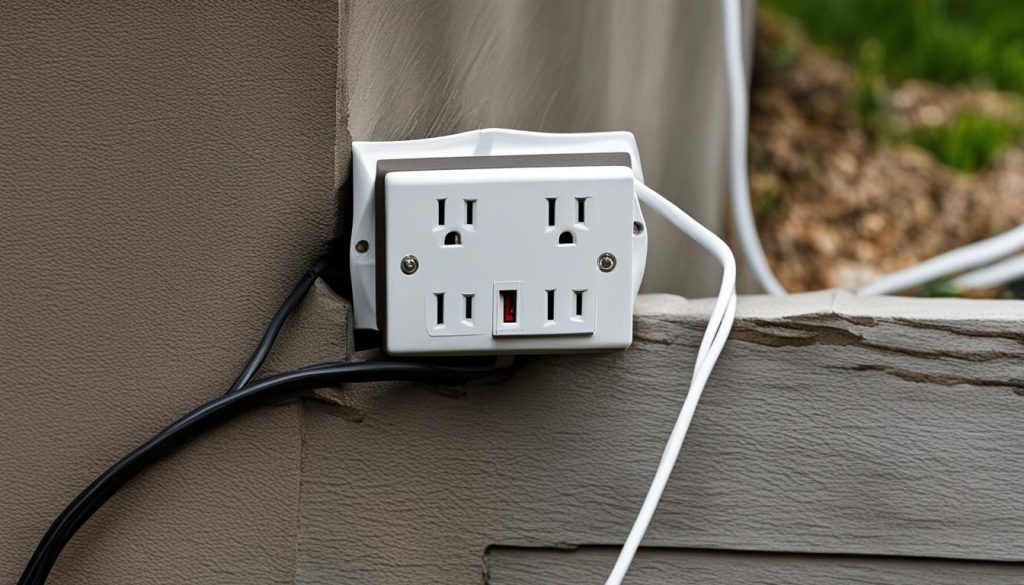
RV Electrical Hookups at Campgrounds
When staying at a campground, it is important to understand the electrical hookup options available. Campgrounds may offer full hookups, which include electricity and water, or provide either a 30 Amp or 50 Amp electrical hookup system.
A 30 Amp RV hookup system provides 3,600 watts of power, while a 50 Amp RV hookup system can supply more than 12,000 watts. The main difference between the two is the power capacity, with the 50 Amp hookup allowing you to run multiple appliances without tripping the breaker.
When connecting your RV to a campground’s electrical hookup, it is crucial to ensure that you have the correct adapters for your RV’s electrical system and the campground’s hookup. Cruise America RVs are equipped with 30 Amp and 15 Amp adapters, making it easier to connect to different campground electrical systems.
To give you a better understanding, here’s a comparison of the two types of RV electrical hookup systems:
| RV Electrical Hookup System | Power Capacity |
|---|---|
| 30 Amp | 3,600 watts |
| 50 Amp | 12,000+ watts |
With a 50 Amp hookup, you have a higher power capacity, allowing you to run more appliances simultaneously without the risk of tripping the breaker. However, it’s important to note that not all campgrounds offer 50 Amp hookups, so it’s essential to check ahead of time and be prepared with the appropriate adapters.
Remember, the electrical hookup at campgrounds plays a vital role in powering your RV, so understanding the available options and ensuring compatibility is essential for a comfortable and enjoyable camping experience.
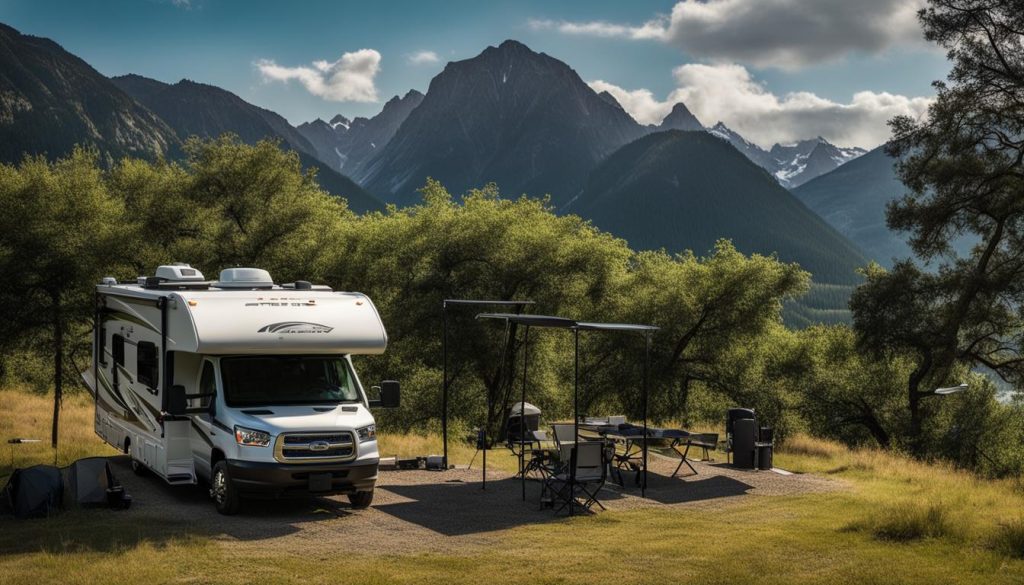
Continue reading to learn the step-by-step process of connecting your RV to a campground’s electrical hookup system.
Steps to Connect Your RV to Campground Electrical Hookups
When it comes to connecting your RV to a campground’s electrical hookup, following the right steps is crucial for a safe and hassle-free experience. By properly hooking up your RV to the campground’s power supply, you can ensure a reliable source of electricity for all your electrical needs. Here are the steps you should follow:
-
Locate the electrical system and breaker at the campground:
-
Turn off all electrical appliances in your RV and shut off the campsite’s power supply:
-
Plug your RV’s cord into the campground power box, using adapters if necessary:
-
Switch on the campsite’s breaker to restore power to your RV:
Knowing the location of the electrical system and breaker is essential. Typically, you’ll find them in a designated electrical hookup box or pedestal near your campsite. Take a moment to familiarize yourself with the layout and identify the appropriate connections.
Prior to plugging in your RV, make sure all appliances such as air conditioning units, heaters, and other power-hungry devices are turned off. Then, switch off the campsite’s power supply to avoid any electrical surges or accidents.
Connect your RV’s power cord to the appropriate electrical hookup in the campground’s power box. Depending on the electrical system and your RV’s power requirements, you may need to use adapters to ensure a proper fit.
Once your RV’s cord is securely plugged in, it’s time to switch on the campsite’s breaker. This step will restore power to your RV, allowing you to utilize your electrical appliances and systems as needed. Be sure to monitor your RV’s electrical load and avoid overloading the circuit.
Connecting your RV to campground electrical hookups is a straightforward process that ensures you have the necessary power supply for your adventures. By following these steps, you can enjoy a comfortable and convenient camping experience with all the amenities and comforts of home.
RV Electrical Hookup at Home
There may be occasions when you want to connect your RV to your home’s electrical system, such as performing a diagnostic check before a road trip or loading perishable food. While it is important to note that the power capacity of a home’s electrical system may be limited, you can proceed with an RV electrical hookup at home using a three-prong plug connector and a 30/50 Amp adapter for a 15/20 Amp home system. Before connecting your RV to your home, ensure that the breakers are off at your house and all electrical appliances in the RV are turned off. Connect the RV to your home using the three-prong connector and/or adapter and switch on the house’s breakers. It is important to be mindful of the electrical usage and not rely on your home’s electric grid for extended periods to avoid excessive bills.
| Power Requirement | Home Electrical System (15/20 Amp) |
|---|---|
| RV Electrical System | 30/50 Amp |
| Adapter Needed | Yes |
When connecting your RV to your home’s electrical system, it is crucial to follow safety precautions and be aware of the power limitations. Ensuring that the breakers are off before connecting, as well as turning off all appliances in the RV, will help prevent any electrical mishaps. By using the appropriate three-prong plug connector and adapter, you can establish a secure connection between your RV and home. However, keep in mind that relying on your home’s electrical grid for an extended period may result in higher electricity bills.
Things to remember for RV electrical hookup at home:
- Turn off the breakers at your home before connecting your RV
- Check that all electrical appliances in the RV are turned off
- Use a three-prong plug connector and a 30/50 Amp adapter for a 15/20 Amp home system
- Switch on the house’s breakers after connecting the RV
- Be cautious of electrical usage to avoid excessive bills
By following these steps and understanding the power limitations, you can safely connect your RV to your home’s electrical system for short-term purposes. However, for longer stays or consistent power supply, it is recommended to seek alternative power sources or consult a professional for appropriate electrical hookups.
Conclusion
So, whether you’re plugging your RV into your home’s electrical system or connecting it at a campground, it’s crucial to be aware of the power limitations and safety precautions to ensure a smooth and hassle-free experience. Remember to always follow the recommended steps, such as turning off appliances before plugging in, using the correct adapters if necessary, and being mindful of power usage.
By understanding the specific requirements of your RV’s electrical system and the available power supply at your intended location, you can avoid overloading the system and tripping breakers. If you have any doubts or concerns, don’t hesitate to consult knowledgeable forums, dealerships, or fellow RVing enthusiasts for guidance and assistance.
Plugging your RV into your home or campground’s electrical system can offer temporary power and convenience, but safety should always come first. So, take the necessary precautions, be informed, and enjoy your RV adventures without any electrical mishaps!
FAQ
How do I safely plug my RV into my home’s electrical system?
Before plugging your RV into your home’s electrical system, make sure to turn off all electrical appliances in your RV and the breakers in your house. Use an outdoor, all-weather extension cord and a 15/20 Amp adapter to connect your RV to a standard household outlet. If the breaker trips, unplug everything, check that all appliances in your RV are off, and try again. If the issue persists, refer to your RV’s manual or contact the manufacturer for assistance.
What appliances can I safely use with a home electrical connection?
With a home electrical connection, you can generally use appliances such as TVs, DVD players, laptops, and refrigerators without overloading even a 15/20 Amp connection. However, appliances that require more power, such as air conditioning, heaters, hairdryers, microwaves, toasters, and toaster ovens, should be used cautiously. Running these appliances for extended periods or simultaneously with other power-hungry devices can lead to flickering lights or tripping the electrical connection between your RV and home.
What are the electrical hookup options at campgrounds?
Campgrounds may offer full hookups, which include electricity and water, or provide either 30 or 50 Amp electrical hookups. A 30 Amp hookup provides 3,600 watts of power, while a 50 Amp hookup can supply more than 12,000 watts. With a 50 Amp hookup, you can run multiple appliances without tripping the breaker. Make sure you have the correct adapters for your RV’s electrical system and the campground’s hookup.
How do I connect my RV to a campground’s electrical hookup?
To connect your RV to a campground’s electrical hookup, locate the electrical system and breaker at the campground, turn off all electrical appliances in your RV, and shut off the campsite’s power supply. Plug your RV’s cord into the campground power box, using adapters if necessary, then switch on the campsite’s breaker to restore power to your RV.
Can I plug my RV into my home’s electrical system?
Yes, you can plug your RV into your home’s electrical system using a three-prong plug connector and a 30/50 Amp adapter for a 15/20 Amp home system. However, be mindful of the power limitations of your home’s electrical system and use the appliances sparingly to avoid overloading the system or tripping breakers.
What are the key considerations when plugging an RV into a home’s electrical system?
When plugging your RV into a home’s electrical system, it’s important to note that the power capacity may be limited compared to a dedicated RV hookup. Be aware of the appliances you can safely use without overloading the system, and avoid running power-hungry devices for extended periods or simultaneously. Always follow the recommended steps, use appropriate adapters if needed, and ensure the safety of both your RV and the electrical system.

